Is Amazon Inventory Placement Service the Right Choice for the Sellers?
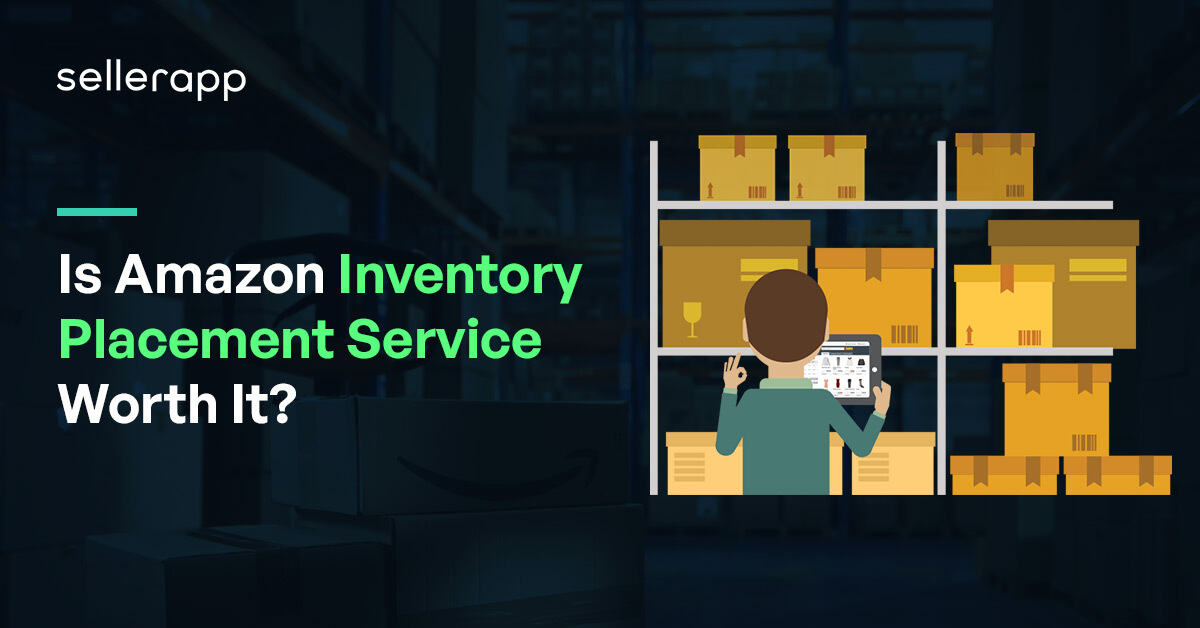
In the dynamic world of e-commerce, efficient inventory management can be the difference between success and stagnation.
Amazon provides a robust platform for businesses to reach a global audience, but it also presents unique inventory management hurdles.
These challenges include optimizing shipping costs, meeting customer delivery expectations, and handling fluctuations in demand, especially during peak seasons like holidays or sales events.
This is where Amazon Inventory Placement comes into play.
It offers a strategic solution to these challenges, allowing sellers to regain control over their inventory distribution and management.
Through this service, inventory can be efficiently placed in Amazon’s fulfillment network, streamlining processes and enhancing customer experiences.
In this article, we will delve into the challenges it addresses and the solutions it offers. Also, we will uncover its key features, advantages, and considerations, providing you with the insights needed to make informed decisions that align with your business goals and aspirations.
Quick Guide
- What is Amazon Inventory Placement Service?
- Is Amazon Inventory Placement Service free?
- How to use Amazon Inventory Placement FBA
- Is Amazon Inventory Placement right for you?
- Pros and cons of Amazon Inventory Placement Service
- Conclusion
What is Amazon Inventory Placement Service?
Amazon Inventory Placement Service (IPS) is a feature offered by Amazon to its sellers, allowing them to control how their products are distributed and stored within Amazon’s fulfillment network. IPS gives sellers the option to either have their inventory placed in a single fulfillment center (known as “Inventory Placement”) or to have it distributed across multiple Amazon fulfillment centers (known as “Distributed Inventory Placement”). Here’s a closer look at what each of these options entails:
Inventory Placement:
With this option, all of a seller’s inventory is concentrated in a single Amazon fulfillment center. This can be advantageous in certain situations, such as when sellers want to minimize shipping costs, streamline inventory management, or have specific logistical requirements.
Distributed Inventory Placement:
In contrast, this option allows Amazon to distribute a seller’s inventory across multiple fulfillment centers. Amazon uses its algorithms to determine the most efficient locations for each product based on factors like historical sales data, customer demand, and shipping cost optimization. Distributed Inventory Placement, especially when inventory is strategically spread across multiple fulfillment centers, can play a pivotal role in enhancing the speed and reliability of deliveries, especially when confronted with high-demand seasons.
Besides, Amazon charges additional fees for using Inventory Placement Service, which can vary based on factors like the type and size of products, time of year, and the specific fulfillment centers involved. While choosing this option, you should carefully consider your inventory management strategy and costs before deciding whether to use the Inventory Placement Service.
Amazon Inventory Placement Service offers greater flexibility and control over inventory distribution, helping you optimize the operations on the Amazon marketplace.
Is Amazon Inventory Placement Service free?
It’s important to note that while this service offers convenience, it is not free. Amazon will charge you a per-unit fee based on the weight of each SKU (Stock Keeping Unit) when you choose to opt into the Inventory Placement Service through your seller account.
Standard-Size per unit (includes all Standard-Size product size tiers)
| 1 lb. or less | $0.30 |
|---|---|
| 1 - 2 lb. | $0.40 |
| Over 2 lb. | $0.40 + 0.10/lb. above the first 2 lb. |
Oversize per unit (includes all Oversize product size tiers)
| 5 lb. or less | $1.30 |
|---|---|
| Over 5 lb. | $1.30 + $0.20/lb. above the first 5 lb. |
This fee covers the cost of Amazon’s efforts to handle the distribution of your inventory. Be sure to carefully consider the costs and benefits before making a decision about which inventory placement option is best for your business.
Determining whether Amazon’s Inventory Placement Service is a cost-effective choice for your specific business is essential. Let’s consider an example:
Suppose you intend to ship 1,000 units of inventory, with each item weighing less than 1 pound. Amazon charges a fee of $0.50 per item, totaling $500 in service fees if you opt for the Inventory Placement Service.
To decide whether this service is beneficial for your business, you need to assess whether the cost savings achieved by shipping to a single location rather than multiple locations outweigh the additional $500 fee associated with the Inventory Placement Service. Ultimately, this evaluation depends on your unique business circumstances and financial considerations. So, carefully assess your options before making an informed decision regarding the cost-effectiveness of using the Inventory Placement Service.
How to use Amazon Inventory Placement FBA
If you want to utilize Amazon’s Inventory Placement Service (IPS), the process for signing up is straightforward. Here are the steps to follow:
- Log in to your Amazon Seller Central account.
- Navigate to the “Settings” section and choose “Fulfillment by Amazon.”
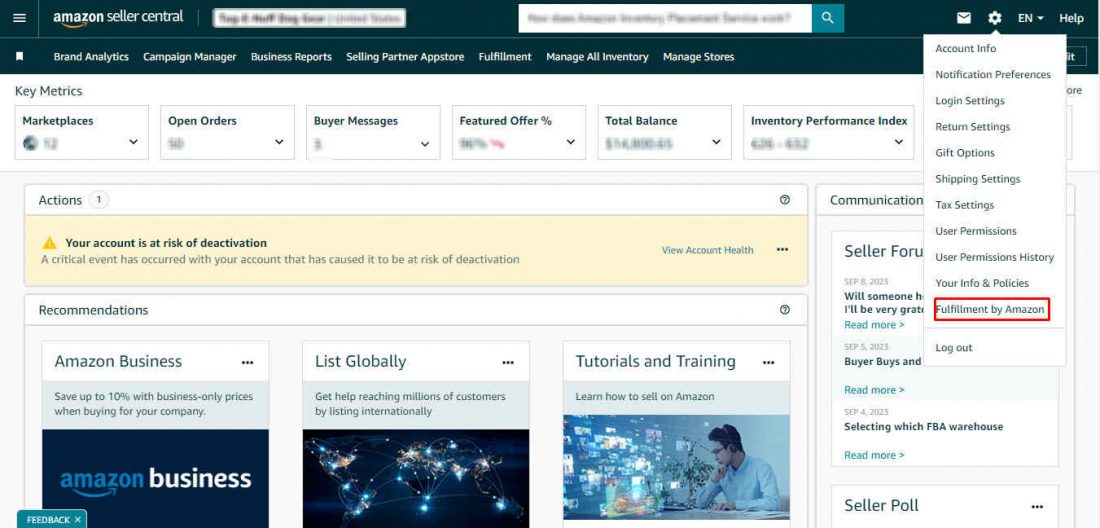
- Within the “Inbound Settings” category, click “Edit.”
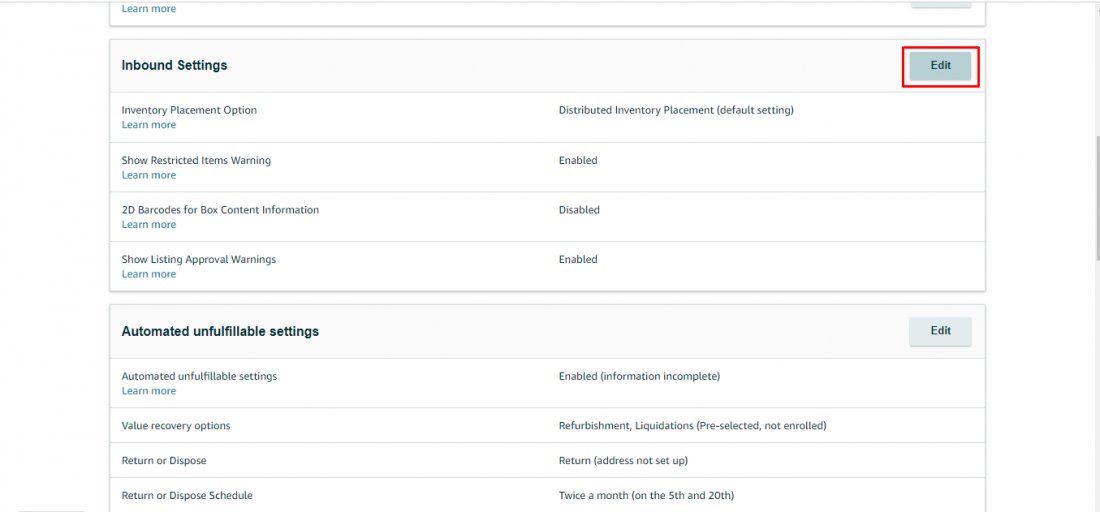
- Locate the “Inventory Placement Option” and choose “Inventory Placement Service.”
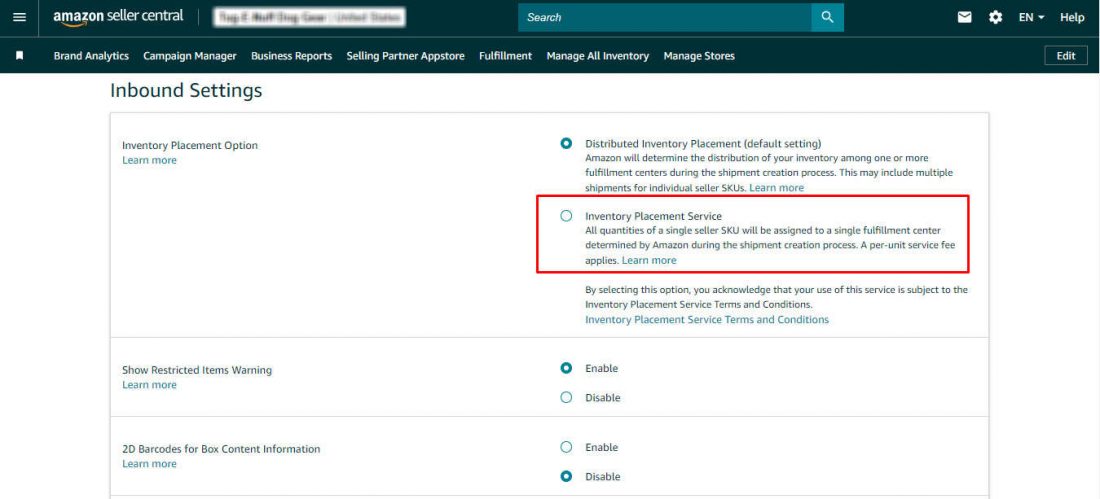
- Save your changes by clicking the “Update” button.
By following these steps, you can easily enable the Inventory Placement Service for your Amazon FBA inventory.
To learn more about Amazon Inventory Placement Service, check out this video:
Is Amazon Inventory Placement right for you?
Sending all your inventory to one location using Amazon’s Inventory Placement Service may seem like the most convenient option at first glance. However, it’s crucial to recognize that this approach doesn’t suit every business equally. In fact, depending on factors such as your SKU (Stock Keeping Unit) type and the volume of inventory you handle, the expenses associated with using the Inventory Placement Service could potentially outweigh the advantages.
Amazon’s Inventory Placement Service tends to be a suitable choice for businesses whose inventory meets specific criteria.
Smaller Shipments and Inventory Volumes
Amazon’s Inventory Placement Service is particularly advantageous for sellers who handle smaller inventory volumes, which often result in smaller shipment sizes. For these businesses, this service offers significant cost savings because it helps them avoid the high shipping costs linked to independently distributing their inventory. With fewer items to ship, the Inventory Placement Service fee remains manageable and doesn’t outweigh the cost savings achieved through streamlined distribution.
Small and Lightweight Products
The fee structure for Amazon’s Inventory Placement Service is contingent on the weight and dimensions of each item, with larger or oversized items incurring higher fees. Consequently, businesses specializing in small, lightweight products that are simple to ship will experience lower fees. This makes it a cost-effective choice for such businesses.
Products with profit margins
While utilizing the Inventory Placement Service can lead to savings on distribution costs, the extent of these savings may vary. In such cases, it’s advisable for businesses to consider using this service primarily for products with substantial profit margins rather than those with slim margins.
Pros and cons of Amazon Inventory Placement
Before making a decision about whether to use Amazon’s Inventory Placement Service, it’s essential to thoroughly evaluate both its pros and cons. To assist you in determining if this service aligns with your business needs, let’s explore some of the key benefits and drawbacks associated with Amazon’s Inventory Placement Service.
Pros of Amazon Inventory Placement
Amazon Assumes Distribution Responsibility
Once your inventory shipment arrives at the designated Amazon receiving or fulfillment center, you can entrust Amazon with the entire logistics process.
Amazon will efficiently handle the task of dividing your inventory and subsequently redistributing it to various fulfillment or distribution centers. This relieves you of the burden, saving you valuable time and reducing stress associated with distribution logistics.
Furthermore, orders will continue to be dispatched from the fulfillment center nearest to the customer’s delivery location, enhancing shipping speed and reducing shipping expenses. In totality, these cost and time savings can be especially advantageous, particularly for businesses operating with limited resources and a smaller workforce.
Single Shipping Destination
When utilizing Amazon’s Inventory Placement Service, you simplify your shipping process by sending all your inventory to a single designated shipping address. Amazon will allocate a fulfillment center based on factors like your product type and the origin of your shipment.
This means that, unless your products fall under specific exceptions, you no longer need to dispatch your inventory to fulfillment centers located farther away. This streamlines your supply chain, resulting in significant cost savings as your shipments typically cover shorter distances, traverse fewer shipping zones, and eliminate complexity from your logistics operations.
Ideal for Smaller Shipments
Amazon’s Inventory Placement Service can be an excellent choice when dealing with a limited quantity of inventory. It eliminates the necessity to divide a small inventory into numerous FBA shipments, which not only adds complexity but can also incur significant expenses.
Cons of Amazon Inventory Placement
Potential for High Costs
The use of Amazon’s Inventory Placement Service may lead to higher expenses, depending on factors such as the weight and quantity of SKUs that need to be shipped.
For standard-size products weighing less than 2 lbs, the cost per item typically ranges from $0.30 to $0.40. However, oversized items incur a minimum fee of $1.30, with items weighing over 5 lbs incurring even higher costs.
Consequently, the expenses associated with using this service can accumulate significantly, especially for oversized or heavy items, as well as for substantial inventory volumes. While one seller might realize cost savings when employing the service for 200 units of inventory, another seller with 2,000 units to ship could potentially end up spending more. It’s essential for sellers to carefully consider the cost implications when deciding whether to use the service.
Limited Applicability to Specific Items
While the Inventory Placement Service offers a streamlined shipping approach for most standard-size items, it’s important to note that Amazon imposes exceptions for certain inventory categories. Consequently, despite using this service, certain items will still be directed to different receiving or fulfillment centers. These exceptions typically include:
- Apparel
- Jewelry
- Shoes
- Media
- Oversized items
- Hazardous materials
- Inventory tracked with a manufacturer barcode
- Items requiring Amazon prep
- Items requiring Amazon labeling
These exceptions arise because specific items necessitate specialized handling or storage conditions, and only certain receiving centers and fulfillment centers possess the required capabilities. While these exceptions might result in inconveniences and complexities, they can also diminish the cost savings typically associated with the Inventory Placement Service.
Extended Delivery Timeframes
The use of Amazon’s Inventory Placement Service can result in longer lead times compared to the direct shipment of inventory to final fulfillment centers. This is because once your inventory reaches the initial transit hub, Amazon undertakes the process of redistributing it to other fulfillment centers.
Consequently, items spend more time in transit before becoming available for purchase. This extended duration might lead to the presentation of your products to Amazon customers with a future ship date.
Given the longer delivery times associated with the Inventory Placement Service, it is imperative to plan inventory replenishment well in advance. This proactive approach helps prevent stockouts and ensures that you don’t miss out on valuable sales opportunities.
Conclusion
Amazon Inventory Placement Services is a valuable tool for e-commerce sellers looking to streamline their inventory management on the Amazon platform. It offers the convenience of centralized distribution, potentially reducing shipping costs and ensuring faster delivery times for customers.
Whether you opt for Inventory Placement Services or choose different distribution methods, the key lies in aligning your strategy with your unique business needs and goals. With a thorough understanding of how IPS works and its implications, you can make informed decisions that contribute to your success on Amazon’s ever-evolving e-commerce landscape.





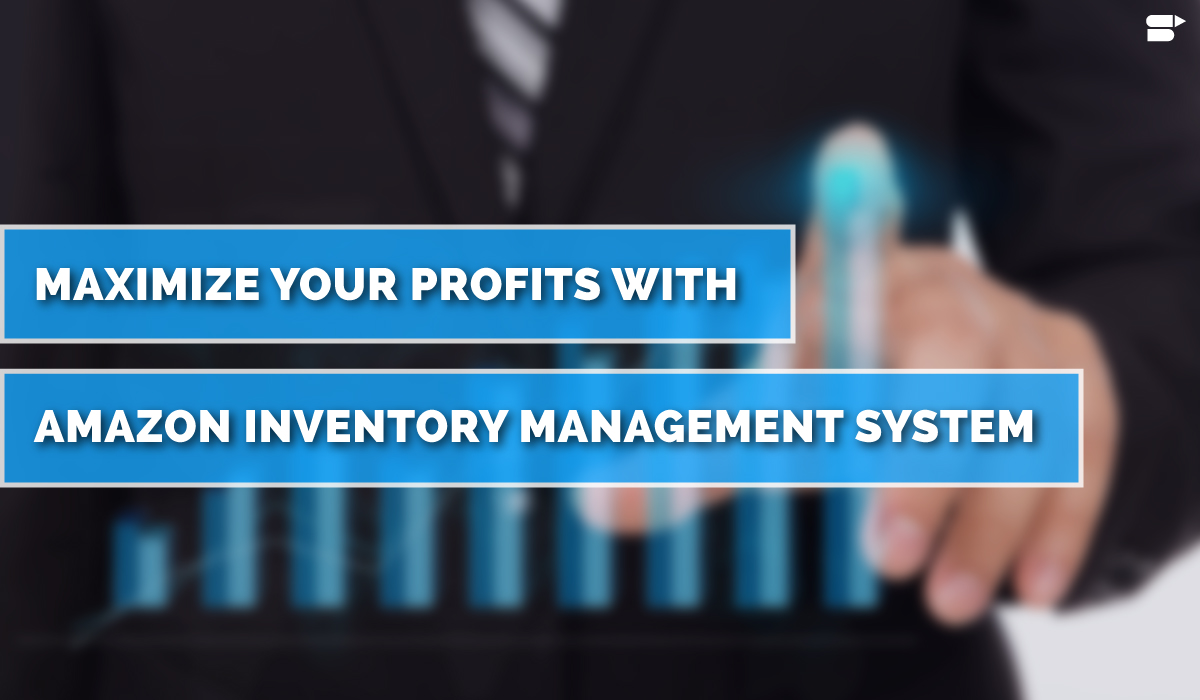



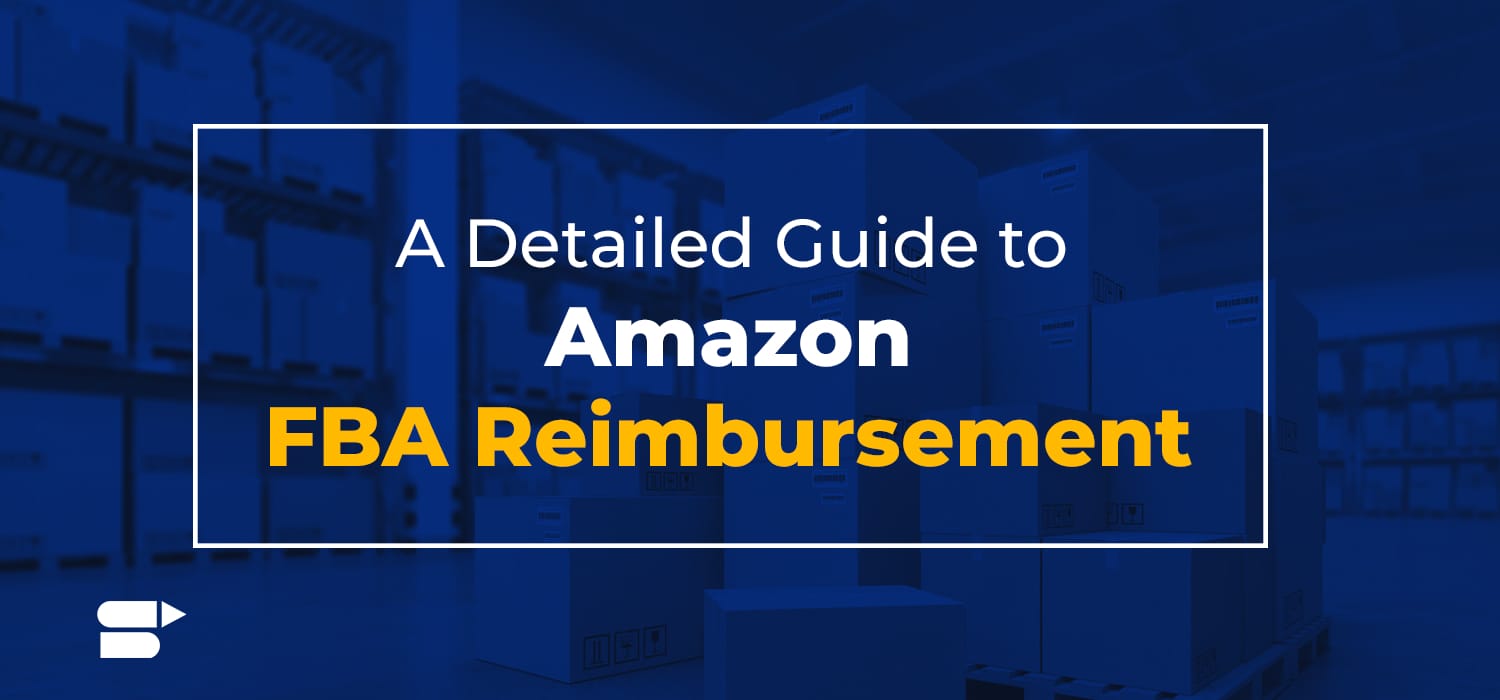

Alexender
October 29, 2023Quick and to the point! This article helped me decide if Amazon’s Inventory Placement Service is a game-changer for sellers. Thanks for the clarity!
Clare Thomas
March 12, 2024Very happy to hear that.